|
Elwell-Parker,
Limited
Thomas Parker and his family moved to
Wolverhampton from Coalbrookdale, in October 1882. Thomas had agreed
to go into partnership with Paul Bedford Elwell, to manufacture
accumulators at Paul’s premises in Commercial Road, from where he
ran the Patent Tip and Horseshoe Company. The Parker family lived in
St. Jude's Road and their daughter Jessie Eliza was born there in
March 1886.
|
| Paul Bedford Elwell was born on 7th
February, 1853, in Albrighton, the second son of Wolverhampton
merchant, Paul Elwell. He was educated at King’s College, London where he obtained
a distinction in mathematics, and spent a year at Liège studying
coal mining and iron manufacturing. His wife Elizabeth was born
in Wolverhampton and in the 1881 census they are recorded as
living at "The Cottage", Ryton, Shifnal, Shropshire, with one
son, Paul L. Elwell, aged 7 months.
Paul Bedford Elwell's occupation is listed as 'the manager
of a works making nails etc., employing 100 hands'. By 1882 the
family had moved to St. Cuthbert's, Albrighton. The Commercial
Road Premises was rented from the owner; J. Smallman.
According to an article in the Birmingham Daily Post on 20th
July, 1864, what must have been the Patent Tip and Horseshoe
Company in Commercial Road, was placed in the hands of the
Elwell family after they loaned more money to the firm.
|
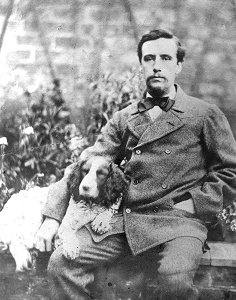
Thomas Parker and his dog. Courtesy of
Gail Tudor. |
| The manager was Alexander Stocker, previously of the
Bordesley Iron Works. In 1835 he acquired a patent for
his improved method of producing horseshoes. It seems
that Stocker founded the Patent Tip and Horseshoe
Company with money provided by the Elwells, on the
understanding that the horseshoes would only be supplied
to them. |
|
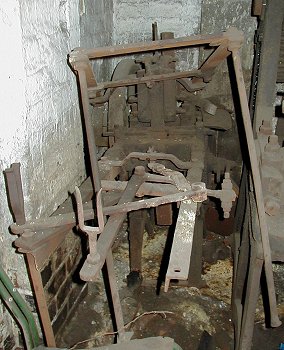
The surviving Elwell nail making
machine. |
In 1864 Charles and Paul Elwell dismissed Stocker
because of his absence from the business, and he took
them to court over the matter. In 1871 Paul Bedford
Elwell was clerk to the Patent Tip and Horseshoe
Company, and by 1876 was managing the firm. He took out several patents. The
first for nail-making machinery was registered in 1876,
the second, registered in 1878 was for shoe tips, and
the third, registered in 1879, was for Venetian
blinds.
What is almost certainly the only surviving Elwell
nail making machine was found in 2004 at the Crown Nail
Company in Commercial Road, where it had been in store
for over 100 years.
The machine has been rescued by the Black Country
Living Museum and is currently in store. Hopefully one
day it will be restored and put on display. It must be
one of the oldest, if not the oldest surviving British
cut-nail machines. |
| Another view of the Elwell
cut-nail machine showing his patented oscillating feed
arrangement.
In a conventional cut nail
machine the steel strip from which the nails are cut is
turned over between each cut, to eliminate waste. This
involves a rotating feed mechanism, which is eliminated
in Elwell's design, by the oscillating feed. |
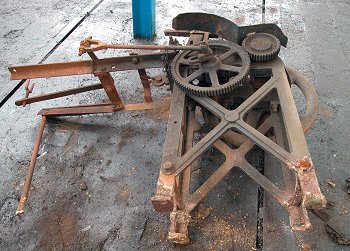 |
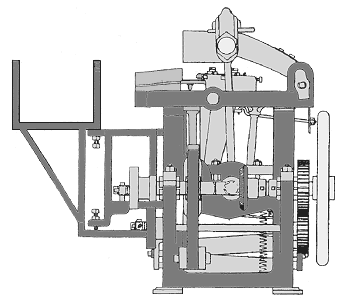
A drawing of another Elwell
cut-nail machine, also with an oscillating feed, which
can be seen on the left. |
|
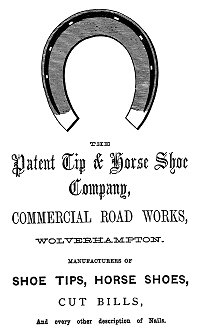
An advert from 1871.
|
Initially the company had premises on the southern side
of the Crown Nail Company in Commercial Road. On 17th April 1882
Elwell purchased part of the large factory that stood on the
corner of Walsall Street and Commercial Road, on the other side
of the Crown Nail Company's works. Further space at the works
was acquired on 24th June.
In the early days, Elwell had little knowledge of electricity,
and so left that side of the business to Thomas. The new company
was housed in a corner of the Commercial Road works, the
electrical department staff consisting of Thomas, one of his sons and a man.
Dynamos were needed at the factory for lighting and for
charging accumulators. Unfortunately the dynamos used at the
works, like many of the dynamos available at the time, were
unreliable and not up to the job in hand. Thomas decided to
design an improved dynamo that would reliably and efficiently
provide power, both for the company's own needs and as a new
product. The first Elwell-Parker dynamo was completed in
October, 1883 and was a great success.
|
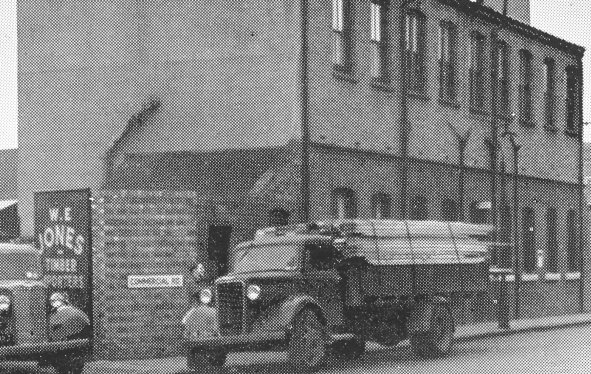
A view from 1954 of the offices of W. E.
Jones timber importers who occupied the site of the Elwell-Parker
factory. It could well be that the building was once the Elwell-Parker
offices. It is now long-gone. |
|
Thomas described his early years at
Wolverhampton, in a speech that he gave to the Directors of the
Liverpool Overhead Railway, on 7th January, 1893:
| As to our work at Wolverhampton, I may tell you that
Wolverhampton ten years ago had no thought of being guilty of
building dynamos, but there came a circumstance, that
circumstance being an individual, myself, who went to
Wolverhampton and thought that he could build dynamos. That was
October 1882.
I took with me my boy and began by employing one
man. We first built accumulators and afterwards began to build
dynamos. The first one built, I remember it well, it was a
waster, I thought, and it lay in the shop after I had tried it.
It did not do what I wanted it to do, but there was a difficulty
in Lancashire of coating calico printing rollers with nickel,
and Mr. Freemantle paid a visit to Wolverhampton to see what we
were doing. He was secretary of the Manchester Edison Company,
and he was also associated with some of the people who were
trying to cover their rollers with nickel. He said they had
tried every dynamo, and he came to ask me how to get over the
difficulty. I told him there was one there that could do what he
wanted, if it didn’t we would take it back.
We went to
Manchester; at first they could do nothing with it. On following
it to Manchester, I saw at once what they required, and in a few
hours I coated their rollers with nickel. I received a £40
cheque from Mr. Freemantle, with a testimonial, and that was the
first dynamo built in Wolverhampton, the year being 1883. I was
encouraged to build one for lighting, this was a success, and
got us an order for six. We received from the Manchester Edison
Company of that time, £1,000 in advance for building dynamos:
this was the beginning of Elwell-Parker, and of dynamo
manufacturing at Wolverhampton. |
|
|
| In 1883, the company designed, built, and installed
dynamos and electric lighting for the Trafalgar Collieries
in the Forest of Dean. This was the first underground
electrical installation in the country, if not in the world.
The electrical equipment included a 1.5hp. motor that was
attached to a pump to lift water 300 feet from below the
surface. In the same year Paul Bedford Elwell was promoted
to captain of the local Rifle Volunteers. |
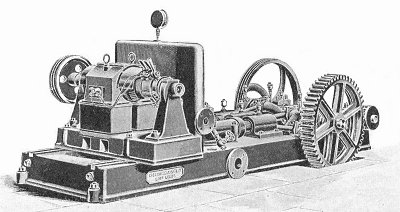
The Elwell-Parker motor attached
to the Greenwood and Batley pump as part of the
installation at Trafalgar Collieries. From the October
1902 edition of Feilden's Magazine. |
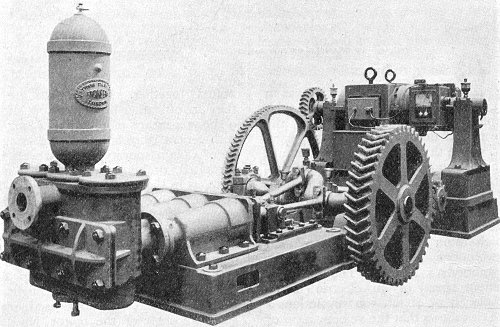
Another Elwell-Parker motor
fitted to a Greenwood and Batley pump. From the October
1902 edition of Feilden's Magazine. |
| |
|
| Read a description of
the Elwell-Parker accumulators from The Engineer
magazine |
 |
| |
|
|
An order was also received for six dynamos from the
Manchester Edison Company, and they were paid a £1,000 in advance.
The rapid success of this part of the business overshadowed
horseshoe manufacture, which soon ceased; and in 1884 the company
became the Wolverhampton Electric Light, Power, Storage and
Engineering Company. This name was soon changed to Elwell-Parker,
Limited, after an infusion of fresh capital.
Mr. Parker made the acquaintance of Mr. Charles
Moseley of Manchester, through Mr. George Freemantle, who was then
the secretary of the Edison Company. Mr. Charles Moseley became
chairman of Elwell-Parker, who at the time employed thirty men at
the works in Commercial Road. By 1885 the amount of business had
increased to such an extent that considerable extensions to the
premises were necessary. Elwell-Parker accumulators were successfully
tested at the Bush Hill estate, near Enfield4
in 1883. This estate was a property development in which Elwell and
several relations had invested heavily. Unfortunately their
investment was not a success and they eventually lost a lot of
money.
|
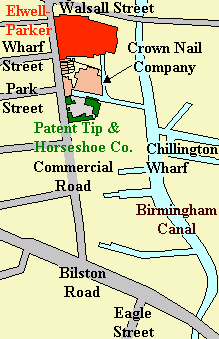
The location of Elwell-Parker, Ltd.
|
| |
|
| Read about the steam engine
designed by Elwell and Parker to power their dynamos |
 |
| |
|
An Elwell-Parker accumulator had also been in use
since 1882 at Elwell's home, St. Cuthbert's, Albrighton. In October
1885, Elwell described the effects of a lightning strike that had
occurred at the house, to the British Association in a meeting at
Aberdeen. From his description it was obvious that both Elwell and
Parker had done a first class job with their wiring. He told the
Association that he occasionally used one of his telephone cables
for the dual purpose of carrying power for lighting and receiving
operatic music from the theatre at Wolverhampton, which was a good
10 miles away.
In 1883 Paul Bedford Elwell is listed in
Crocker's Directory, as being the Managing Director of the Patent
Economic Coal Company, Limited, Commercial Road. He obviously had
other business interests than his partnership with Thomas Parker.
|
|
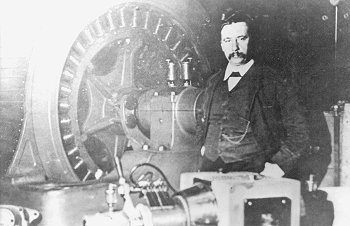
|
Thomas, surrounded by Elwell-Parker
products. In the background is a revolving field alternator, on
the right is a transformer and in the foreground a dynamo.
Courtesy of Gail Tudor.
|
|
The modern type of dynamo was developed by the
Belgian electrical engineer, Zénobe-Théophile Gramme, in Paris, in
1869. His D.C. generator used a ring armature, consisting of a coil
of wire wound on a ring of iron, which rotated in a two-pole
magnetic field. He patented the principle and effectively prevented
others from modifying his design until the patent ran out in 1884.
When the patent expired, dynamo manufacturers seized the opportunity
to produce a more efficient and cheaper machine, and Elwell-Parker
led the way.
In 1885 Sir William Preece, speaking before the
Royal Society of Arts, said that the revival of the electricity
industry in this country was due to the efforts and success of Mr.
Parker, and writing in the Royal Society of Arts Journal, he praised
Mr. Parker for winning a place for Britain in the fast developing
electrical industry. In the same year Thomas was made a member of
the Institution of Electrical Engineers.
|
The following is from 'The Engineer', 13th June,
1884:
Engineering at the Staffordshire
Exhibition
The machinery and industrial
sections in the Wolverhampton and Staffordshire
Industrial and Art Exhibition, which was opened on
May 30th, and will remain open until the end of
October, are well-filled with excellent specimens of
engineering and similar work. The buildings are
shortly to be lighted-up on the incandescent system
by the Wolverhampton Electric Light Engineering and
Storage Company.
The stand of Messrs. Crossley Brothers, Manchester,
who were represented by their Wolverhampton agent,
Mr. H. P. Lavender, contains a small "Otto," a
Parker-Elwell dynamo, and a Parker-Elwell, Planté
accumulator, all engaged in exhibiting on a small
scale, the incandescent system of domestic electric
lighting by Mr. T. Taylor Smith. The dynamo drives
twelve lamps of 20 candle power each. The Otto is of
½ horse power nominal and 1·9 horse power indicated,
and the dynamo has been made specially for that size
of engine. The arrangement is the same as that used
to light-up by several of the swan companies. Though
on a small scale, it is an object of much interest
to the visitors at night. |
|
|
Ellwell-Parker Limited displayed eleven dynamos
and an electric motor at the 1885 Inventions Exhibition at South
Kensington, and in the same year supplied dynamos for lighting to
the London Stock Exchange and Lloyds of London.
| |
|
| Read a detailed technical
description of the Elwell-Parker products displayed at
the 1885 Inventions Exhibition |
 |
| |
|
Thomas continued his links with the Coalbrookdale
Company. Elwell-Parker Limited didn't have a foundry and so most of
their castings were made at Coalbrookdale.
|
|
One of the first large orders secured by the new company was for
the design and construction of the electrical plant for driving
the Blackpool Tramway, the first English electric tramway of any
size. The trams
used a conduit system, where the power was picked-up from a slot
between the rails. The conductor was composed of two
copper tubes of elliptical shape, attached to iron studs The
studs were supported in porcelain insulators, that were mounted
on blocks of creosoted wood in the sides of the channel. At each
end of the car there was a switch box, with resistance coils
placed under the platforms, by which means the strength of the
current and speed of the car could be regulated. |
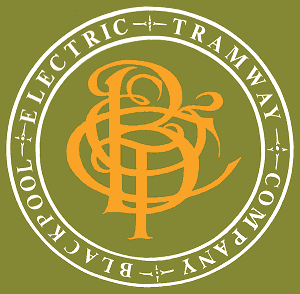 |
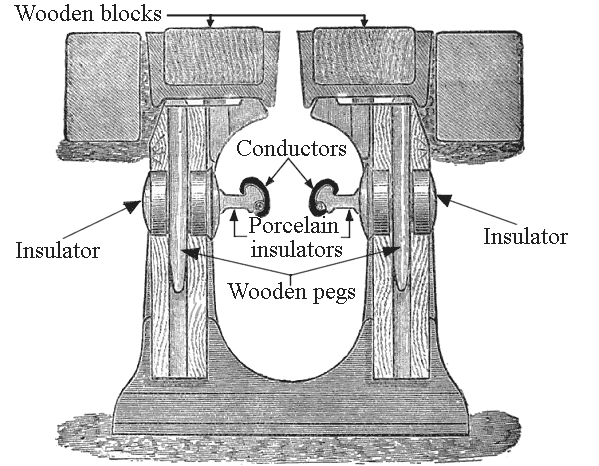 |
A section of the conduit used at Blackpool. |
| To reverse the direction in which the car was travelling, the
direction of the current through the armature was reversed. The
shunt-wound field coils were always magnetised in the same
direction. Each car was driven by a single bipolar, reversible
motor, the drive being transmitted by an open chain to one of the
two truck axles. Work began
on the motors and dynamos in 1884. The first tram ran on 2nd
July, 1885, this was the first electric tram to run along an English
street.
The system was a great advance on any other electrically
powered transport system at the time. It did have some defects
however. Often at high tide, it was completely covered in water
and sand, when the wind blew in from the sea, and many times it
was under several feet of snow. The switchgear became crusted
with sodium and chlorine salts and so could be unreliable. |
| One of the
original trams still survives at the National Tram
Museum, Crich. It was converted to run on an overhead wire, and
ended its career as a service vehicle.
Originally Blackpool tram
number 3, it later became tram number 4. Thomas Parker remained
as the tram company’s consulting engineer until 18925. |
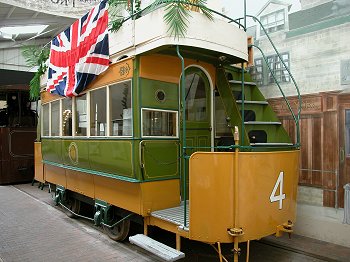
Blackpool tram number 4. |
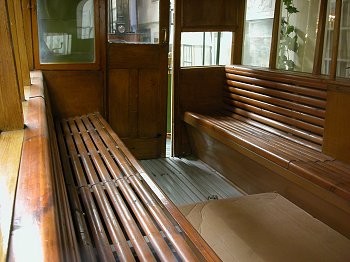 |
The restored interior of
Blackpool tram number 4. This is typical of a public vehicle of
the day and is similar to what was used on many of the
horse-drawn trams. |
|
The underside of Blackpool
tram number 4. The original traction motor has been replaced,
only the end casting remains. The tram is chain driven as can be
seen from the sprockets, the chain having been removed. |
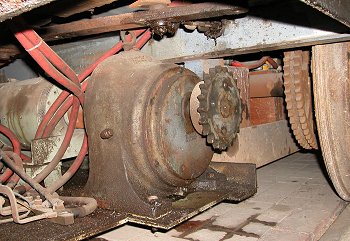
|
|
After the inaugural run, the Mayor of Blackpool
and his guests retired to a celebration dinner in honour of the
opening of the new tramway. After the meal speeches were given and
Thomas Parker said that the future of railways was with electric
traction. Electrically powered locomotives were cheaper to run than
steam and could travel at 70m.p.h.
| |
|
Read a detailed description
of
the installation at Blackpool |
 |
| |
|
Thomas always took a keen interest in electro
chemistry and electro-metallurgy. When the Cowles process for the
manufacture of aluminium bronze was first introduced, he considered
the use of continuous current to be a mistake, and designed an
alternating current furnace, which when tried, proved to be a great
success. Later this would lead to a revolutionary way of producing
phosphorus.
Thomas developed a system of electro-deposition for the refining of
copper and the extraction of gold and silver. Elwell-Parker
made a notable contribution to the electrical purification of
copper, when their dynamos were installed at the Bolton Copper works
at Oakamoor, and revolutionised the purifying process.
|
|
In 1886, Nautilus, the first electric- powered
submarine, was invented by two Englishmen, Andrew Campbell and James
Ash. On the surface it was powered by two internal combustion
engines, but when submerged it was propelled by two 50h.p. electric
motors. They were powered from a 100 cell Electric Power Storage
(E.P.S.) battery, which could power the submarine for as long as
four hours, before recharging was necessary. The submarine achieved
a surface speed of 6 knots, and could cover 80 miles between battery
charges. In 1887 the submarine was fitted with an Elwell-Parker
E.P.S. battery.
|
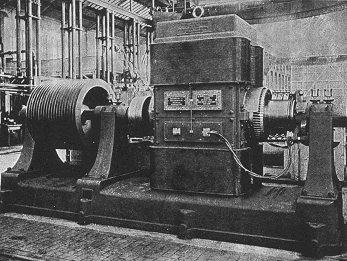
A large Elwell-Parker dynamo. |
| By this time, Elwell-Parker had supplied dynamos to several
local manufacturers including nearby Swan Garden Ironworks run
by John Lysaght, E. T. Wright and Sons at Monmore Ironworks, the
Staffordshire Steel and Ingot Iron Company in Bilston, and
George Wilkinson and Company at Tividale, for use in their sheet
mill. |
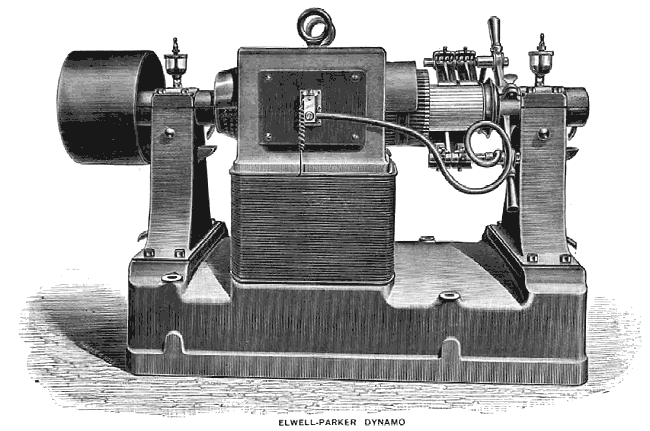
One of the dynamos supplied to the Great
Northern Railway.
| Elwell-Parker supplied three dynamos to the Great
Northern Railway which were used to supply power for lighting in
the locomotive works, and to charge accumulators. Two of the
dynamos had an output of 300 volts at 56 amps, at 840
revolutions per minute. They supplied current to 84 carbon arc
lamps. The third dynamo had an output of 130 volts at 120 amps,
at 880 revolutions per minute. It had a resistance coil
connected to the shunt winding in order to vary the output
voltage. It supplied power to incandescent lamps, and was also
used for charging accumulators. In between 1884 and 1887 Elwell and Parker took
out no less than 14 patents for electrical equipment, either
jointly or separately. Some of their other electrical
installations included Lloyd's offices in the Royal Exchange,
and Manchester Central Station. The "Electrician" for 28th
January, 1887, stated that "Messrs. Elwell-Parker have rapidly
come to the front rank of electrical engineers, and their
dynamos and motors are being widely used". |
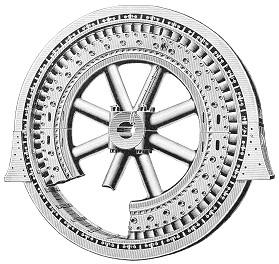 |
Thomas designed and built multi-phase alternators
with a stationary armature and a revolving field of the salient
type. Salient poles were built-up from steel stampings, either
bolted or dovetailed to a frame. This type of design proved to
be very successful and was used for many years.
An alternator with a revolving field
and salient poles. |
|
In 1887 Mr. James Oddie of Ballarat, Australia,
came to England to obtain information on electrical knowledge and
its developments. He was a wealthy gold miner, who became Ballarat’s
first Chairman of the Municipal Council and
was greatly impressed with Elwell-Parker and their products. Whilst
here he visited Blackpool and his description of the trams was
printed in the Ballarat Star, on Friday, 18th
April, 1890. His description is as follows:
|
I had great pleasure in looking at the
esplanade, which is two miles long. It is lit up by nine arc
electric lights and an electric tramway system runs from end to end.
There are 10 cars on it, each capable of seating 55 or 60
passengers. In the summer season, when Blackpool (a favourite
resort) is crowded, 2d is charged for the journey from end to end;
in winter, when visitors are scarce, the same ride may be had for
1d.
This line is one of the sweetest things in
the empire. There is no jar, and the travelling is perfectly lovely.
The motive power in this case is picked up by conductors from an
underground conduit. Through my cousin (Mr. John Nixon, who is a
member of the council, who put up the lights) I had access to the
corporation members and officers and to the managing directors of
the Tramway Company.
While there I gave a dinner to the members
of the corporation and the tramway directors and officers; the mayor
of Manchester, Mr. Alex Siemens (nephew of the late Sir Wm.
Siemens), Mr. Thomas Parker (of Messrs. Elwell and Parker), and
other electricians were present. The dinner went very well and the
proceedings were characterised by enthusiasm. The manager of the
gasworks informed me that the electric light was cheaper than gas,
and that the latter was either 2s.6d or 2s.9d per 1000ft., certainly
not more than 2s.9d.
The electric tramway was so successful that in
the first year it paid a dividend of 5 percent. The second year it
just paid expenses owing to a mishap, the sea getting into the
conduit and partly filling it with sand, the
Job of removing which was most costly. The third year, when it
carried 950,000 passengers (mainly 2d fares), it paid 7 percent. It
is hampered by not being allowed to run on Sundays, while busses
are; otherwise it would beat all opposition.
The power used is obtained from a double set of machinery, two semi
portable engines (worked one at a time) and two Elwell Parker
dynamos, all models of beauty and economy, and which work like
clockwork. The line is a patent of a Mr. Smith, of Halifax, but its
success is mainly due to Mr. Parker.
|
|
In 1887 Thomas Parker developed a process for
the production of phosphorus, and chlorate of soda, by electricity,
which greatly reduced the manufacturing costs. The company also
manufactured alternators and supplied their generating equipment to
Eastbourne, Melbourne, South America, New Zealand, India, and many
other locations throughout the world.
Orders increased, and in 1887 the decision was taken to build
a large new works at Bushbury, on the outskirts of the town.
Land was acquired in Showell Road, but the project was delayed
because of the death of Mr. Charles Moseley, the company’s
Chairman, in October 1887.
On 15th December, 1887 the trial of an Elwell-Parker electrically
powered tramcar took place on the tramline from Wolverhampton to
Willenhall, which was only about 500 metres from the factory. This
must have been the first trial run of an electrically-powered
tramcar on a street in the West Midlands. The car, which had been
ordered by the Australasian Electric Tramways Company was designed
on the lines of the Julien accumulator system developed by Edmond
Julien of Brussels.
The tram was similar to a double-deck, four-wheeled,
horse-powered tramcar, except that the wheels were driven by a
single electric motor, mounted beneath the car, and coupled to the
wheels by gears. Power was supplied by a set of lead-acid
accumulators mounted beneath the seats, and accessible via doors on
the outside. A second trial took place on 4th January, 1888, and
another a short while later which was viewed by representatives from
several tramways, including Birmingham. The trials were a complete
success, and two tramcars, and two sets of batteries were soon
despatched to Australia. In September of that year, one of the cars
was demonstrated on the streets of Melbourne, and in Ballarat in
October.
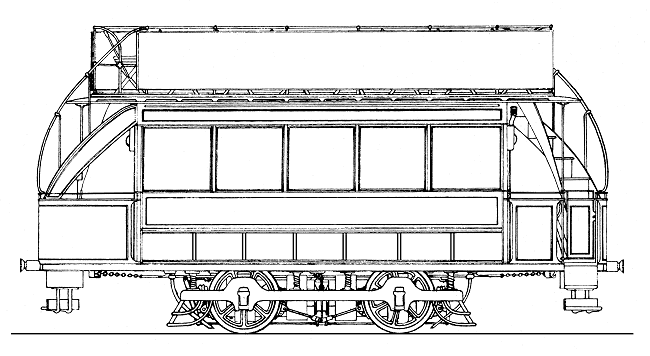
An impression of the electrically-powered
tramcar.
The cars were ordered by Mr. Edmund Pritchard on behalf of the
Australian Company, and led to a legal battle between Mr. Pritchard
and Mr. H. G. C. Woods who had purchased the Australian rights to
the Julien patents. Mr. Woods had expected Mr. Pritchard to pay him
royalties on the patents, but Mr. Pritchard refused because the cars
were built in England under the terms of the English Julien patent
owned by Elwell-Parker, and not in Australia.
Elwell-Parker dynamos were used for many applications. In 1888
one was supplied Erith Ironworks to supply power to an electrically
operated crane. The dynamo provided a supply of 120 volts at 80
amps, at 1,200 revolutions per minute, and was installed in the main
boiler house.
After publishing a translation of Gaston
Planté's book "The Storage of Electrical Energy" in 1887, Paul
Bedford Elwell left the company. This appears to have been due to
two reasons, the forthcoming sale of the business to the Electric
Construction Corporation, and the large amount of debt incurred by the failure of his Bush Hill
estate investments. When questioned by an Australian parliamentary
standing committee in May 1890 about electric tramways, he stated
that "The business was sold to a company in a way of which I did
not approve, and I preferred to clear out."
He sold his house at Albrighton, and went to Paris to prepare
plans for the Paris underground electric railway. Soon afterwards
his bad luck continued. His wife Elizabeth, died of typhoid and he
left for Australia in the hope of finding suitable employment there.
He became Electrical Engineer to the New South Wales Railway
Commissioners, and was responsible for the electrification of Sydney
tramways. He played a leading part in the development of Sydney’s
tramway system, and its power station at Ultimo, the buildings of
which still exist as part of the Powerhouse Museum. Sadly he died
there on 10th September, 1899, at the early
age of 46.
| |
|
| Read Paul Bedford Elwell's
views on tramways |
 |
| |
|
| Read Paul Bedford Elwell's
Obituary |
 |
| |
|
Thomas Parker and the
motor car
Thomas must have been the first motorist in
Wolverhampton, if not in the UK. He claimed to have had an electrically powered
vehicle running as early as 1884 and developed many prototypes
during his lifetime. He religiously obeyed the Light Locomotive Act,
the red flag law, which was only banished in 1896. It set a speed
limit of 4m.p.h. in open country and 2 m.p.h. in towns. The Act
required three drivers for each vehicle, two to travel in the
vehicle and one to walk ahead carrying a red flag. One of his cars
gave over 18 months trouble free service on daily runs to and from
Tettenhall, to the E.C.C. works at Bushbury.
|
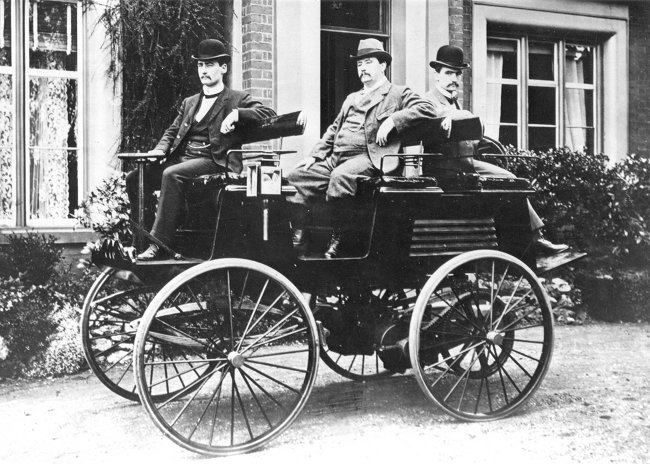
One of Thomas Parker's early cars outside
the family home; The Manor House, Upper Green, Tettenhall.
Thomas is sat in the middle and on the back seat is possibly his
son Alfred.
|
|
During a talk that he gave to the automobile
Club, he described the hilly town of Wolverhampton as being without
a single yard of level ground from Tettenhall to the town. He
groaned at the "Queen Square gradient", which was a real problem
when insufficient batteries limited his progress.
One of his cars
went to London and was shipped to Paris, but the ship floundered in
mid channel and his valuable car was salvaged and brought home. Some
of Thomas's vehicles had hydraulic brakes on all four wheels, as
well as four-wheel steering. These features are even now being
described as revolutionary.
|
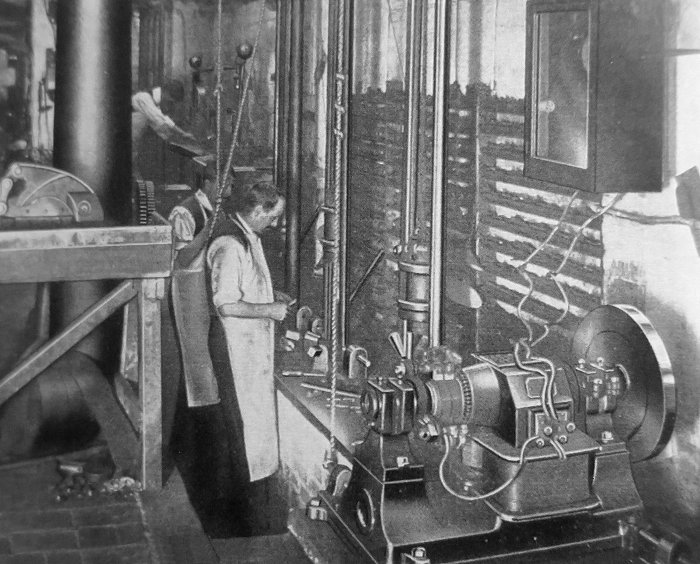
An Elwell-Parker motor, driving a
stamping machine that was used for making jewellery at James
Harrison & Sons, Tenby Street, Birmingham. It is from a
catalogue that is in the collection at the Museum of the
Jewellery Quarter, Vyse Street, Birmingham. |
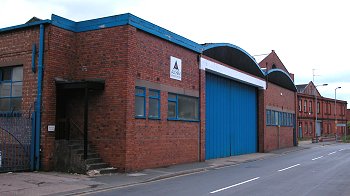 |
The initial Patent Tip & Horseshoe
Company's site on the eastern side of Commercial Road. |
|
The rear of the initial Patent Tip &
Horseshoe Company's site facing the canal. The remains of
their wharf can be seen on the right. |
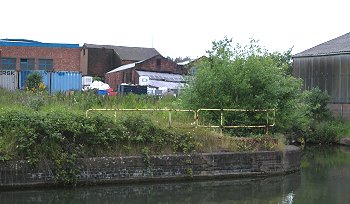 |
|
Birmingham Trams
An order was received from the
Birmingham Tramways Company, for the design and construction
of a prototype electric tram, to run on their existing
system, which was operated by steam trams.
The steam trams were noisy and dirty, and a cleaner and
quieter alternative was required. The decision was taken to
test an electric tram on their system, which would hopefully
fulfil all of their requirements and also be more reliable
and cheaper to run than the existing trams.
It was decided that the tram must be self-powered, as overhead wires
were considered to be unsightly and a conduit system too expensive
to install. A battery-powered prototype was built and successfully
tested at Birmingham, on 7th
November, 1888. It was an instant success and Elwell-Parker expected
further orders.
| Read about the
successful trial of Birmingham’s first electric tram, and a
description of the proposed system |

|
Thomas was a director of the
Douglas Patent Clock and Electric Meter Company of Birmingham,
founded in 1888. The firm produced electricity meters.
One of Thomas's many patents was for a switch that automatically
switched between a battery and a dynamo, so that when the dynamo
ceased to operate, the battery was disconnected. When the dynamo
started again, and the voltage had reached its normal level, the
battery was reconnected to continue charging. It could also be
used in installations where the battery provided backup power
when the supply from the dynamo failed. The following is a brief
article describing the device:
|
From 'Engineering'
magazine, July 15th, 1888.
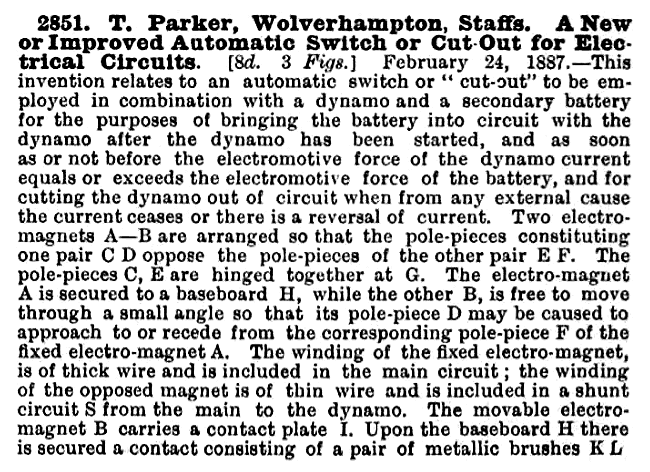
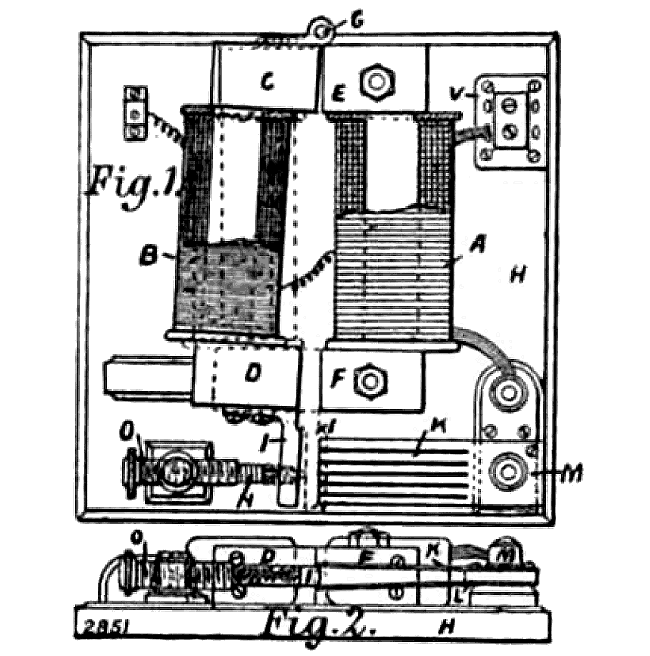
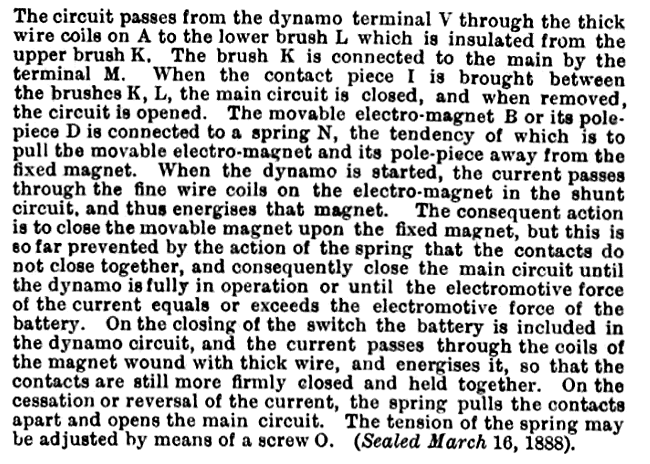 |
|
By 1889 the company had 400 employees, and the
works operated both day and night. In the same year Thomas Parker
became a member of the Institute of Civil Engineers and a rosy
future seemed certain for the company.
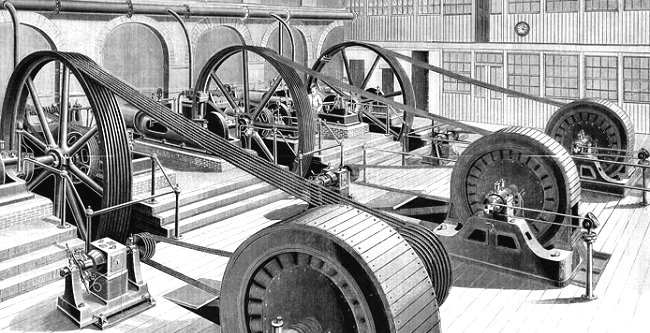
A drawing of the
Kensington Central Electric Lighting Station
from an 1889 edition of 'The Engineer',
showing a small Elwell-Parker dynamo in the
bottom left-hand corner. |
In 1889 Thomas Parker and William Low patented
the Lowrie-Parker dynamo. Several were supplied to Kensington
Electric Lighting Station. Also in 1889 a large syndicate was formed to
manufacture electrical equipment of the type already made by Elwell-Parker. The syndicate founded the Electric Construction
Corporation, Limited and purchased a number of prominent
manufacturing companies to form the new corporation. Thomas Parker
was invited to London in 1888, to meet Mr. Balfour, from the
Corporation, regarding the purchase of Elwell-Parker, Limited. Terms
were agreed and Elwell-Parker, Limited was absorbed into the new
concern, as from 30th September, 1888.

|
|

|
|

|
Return to
Early Years |
|
Return to
the beginning |
|
Proceed to Australia |
|
|